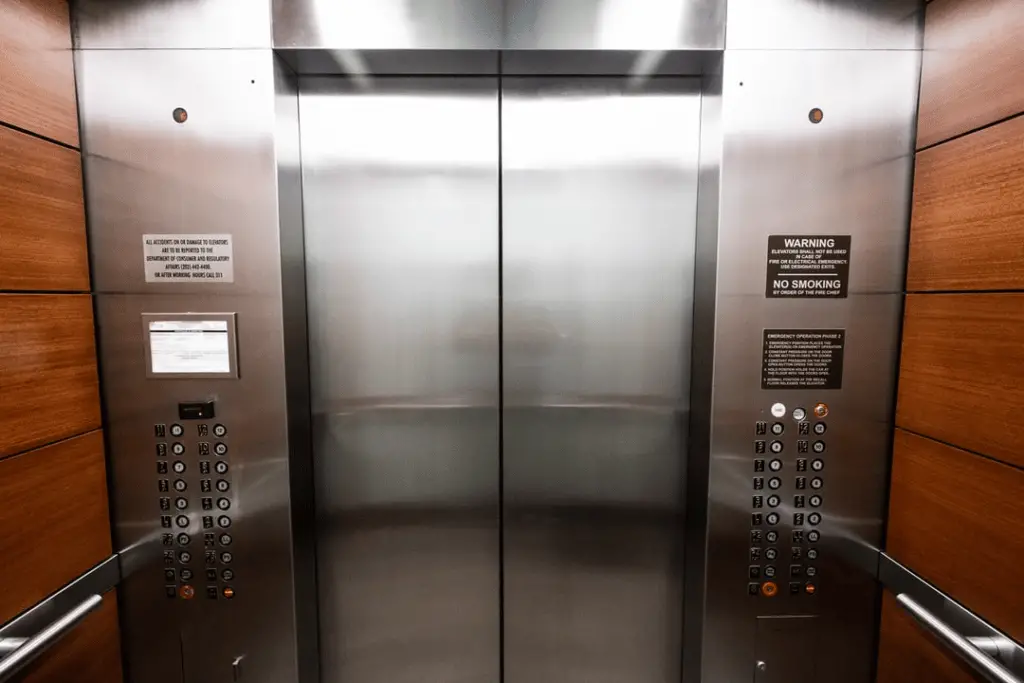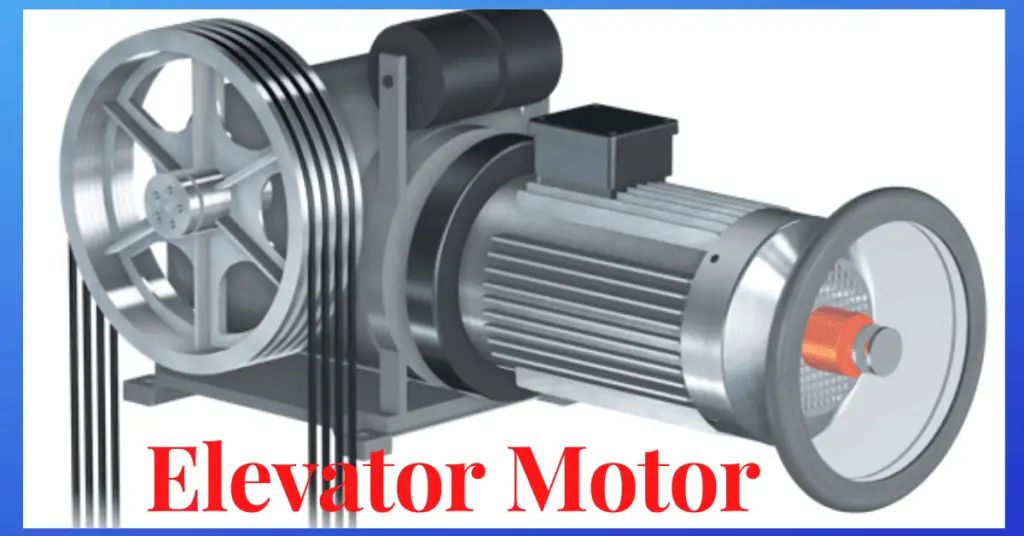This article describes the different types of electric elevator motors. We will also discuss the suitability of different types of electric motors for elevator applications, their speed-torque characteristics, power consumption, and speed control methodology.
What are Elevators?
An elevator is a car that moves in a vertical shaft to carry passengers or materials between the levels of a multistory building.

The elevators are propelled by electric motors using a counterweight through a cables and pulleys system.
What is an Elevator Motor?
An electric motor used for the up and down movement of the elevator car is known as an elevator motor. The motor produces torque and it is transmitted to the rope winding drum. The rope-winding drum wind and unwind the rope according to the forward and reverse rotation of the motor.
The mass of the motor is kept as minimum as possible to have a low moment of inertia. The low moment of inertia helps in the quick acceleration of the motor. Therefore, elevator motors are designed to keep the armature diameter small. The slow-speed motors below 1000 RPM are preferred for elevator applications.
Types of Elevator Motors
Both AC and DC types of motors are used in lifts and elevators.
DC Motors
There are different types of DC motors-series motors, shunt motors, and compound motors- available. However, all types of DC motors are not suitable for elevator services. The selection of the elevator motor depends on the starting torque demanded by the elevator, the type of elevator service, speed and frequency of the slopes.
The principle requirement of the motor is that it should lift up and lift down the load with rapid acceleration and deacceleration without any jerks. The jerks during acceleration and deacceleration cause more wear and tear and moreover, also cause discomfort to the passengers.
The DC motor should be capable to produce at least 250 % of the rated full-load torque, and its speed regulation must be 15 % from no-load to full-load.
The elevators are used for passengers and materials. The different types of DC motors is used for the elevators used for freight and passenger.
- For passenger service – Both compound wound DC motors and DC shunt motors are suitable and give satisfactory results. It has less sparkless commutation and they are suitable for forward and reverse rotation.
- For freight service – The compound wound DC motors are most suitable for this application. The compound wound motor provides a high starting torque because of the series winding. The high starting torque is necessary for lifting and lowering heavy loads.
AC Motors
The following types of AC motors are suitable for elevator applications.
Squirrel Cage Motor
The squirrel cage motor is simple in construction and it is robust because it does not have slip rings and carbon brushes. Speed control can be achieved by the use of a variable frequency drive. It is possible to operate the motor in four quadrants i.e. forward and reverse motoring and braking zone through VFD. The squirrel cage motor of below 25 HP rating is suitable for elevator applications.
Slip Ring Motor
A slip Ring motor delivers more starting torque than a squirrel cage induction motor. It is used when a large rating of the motor is required for elevator application. These motors are suitable for elevators whose car speed is 400 ft./minute and above. A slip ring motors need more maintenance compared to a squirrel cage induction motor.
Permanent Magnet Synchronous Motor (PMSM)
Widely used in modern elevators, PMSMs are known for their high efficiency, compact size, and superior performance. They operate quietly and deliver precise speed control, making them ideal for high-rise buildings. These motors are often paired with Variable Frequency Drives (VFDs) for smooth acceleration, energy savings, and enhanced ride comfort.
Power Requirement of Elevator Motor
In an elevator, the load of the car and the part of the load are counterbalanced by the counterweight. Therefore we need to take the unbalance load into consideration for the power requirement of a motor.
The power of the motor can be calculated by taking the following factors into consideration.
- Speed of elevator car
- Net weight to be hoisted
- The efficiency of the system
The power required in the horsepower of the elevator motor can be expressed by the following formula.

Starting Torque Requirements of Elevator Motor
The elevator demands higher starting torque in comparison to the torque it demands during the running conditions. At start, additional torque is required to overcome the static friction. Therefore, the motor should be capable to deliver 250-300 % starting torque of its full-load torque.
Elevator Control System
The elevator control system is used for the speed control of elevator motors. There are two types of elevator control systems. They are-
Rheostatic Control
A rheostat is added in the field and armature circuit of the DC motor to control the speed of the motor. By changing the value of resistance, the speed is controlled.
Variable Voltage & Variable Frequency Control
The input voltage to the elevator motor varies by some means in variable voltage control. The voltage can be varied by thyristor drive for the DC motor and VF drive for the squirrel cage induction motor.
Conclusion
Elevator motors are the heart of any lift system, ensuring smooth, safe, and efficient vertical movement. Both AC and DC motors are used based on building height, load capacity, and performance requirements. DC shunt and compound motors provide precise control and high starting torque, while squirrel cage and slip ring induction motors are valued for their robustness and low maintenance.
In modern high-rise elevators, the Permanent Magnet Synchronous Motor (PMSM) has become the preferred choice due to its compact design, superior efficiency, quiet operation, and precise speed control.
With technologies like Variable Frequency Drives (VFDs) and thyristor-based control systems, today’s elevator motors deliver outstanding energy efficiency, reliability, and passenger comfort—ensuring safe and sustainable vertical transportation.

Related Articles:
- What is Power? Definition, Unit, Formula, Solved Examples
- Why Starting Torque of Squirrel Cage Induction Motor is Low?
- Application of Squirrel Cage And Slip Ring Induction Motor
- Advantages and Disadvantages of Induction Motor
- How to Calculate Minimum Insulation Resistance Requirement?
- What is a VFD? – Its Working, Applications, Advantages